
ОСМОХАЛЕ ПОРОШОК ДЛЯ ІНГАЛЯЦІЙ (ТВЕРДІ КАПСУЛИ)
Запитайте лікаря про рецепт на ОСМОХАЛЕ ПОРОШОК ДЛЯ ІНГАЛЯЦІЙ (ТВЕРДІ КАПСУЛИ)

Інструкція із застосування ОСМОХАЛЕ ПОРОШОК ДЛЯ ІНГАЛЯЦІЙ (ТВЕРДІ КАПСУЛИ)
Введення
Опис: інформація для користувача
Osmohale порошок для інгаляції (тверді капсули)
манітол
Перш ніж почати приймати цей лікарський засіб, уважно прочитайте весь опис, оскільки він містить важливу інформацію для вас.
- Збережіть цей опис, оскільки вам може знадобитися знову його прочитати.
- Якщо у вас виникли питання, проконсультуйтеся з вашим лікарем або фармацевтом.
- Цей лікарський засіб призначений тільки для вас і не слід давати його іншим людям, навіть якщо вони мають такі самі симптоми, як і ви, оскільки це може їм нашкодити.
- Якщо ви відчуваєте побічні ефекти, проконсультуйтеся з вашим лікарем або фармацевтом, навіть якщо це побічні ефекти, які не вказані в цьому описі. Див. розділ 4.
Зміст опису
- Що таке Osmohale і для чого він використовується
- Що вам потрібно знати перед початком прийому Osmohale
- Як приймати Osmohale
- Можливі побічні ефекти
- Зберігання Osmohale
- Зміст упаковки та додаткова інформація
1. Що таке Osmohale і для чого він використовується
Osmohale - це тестдля визначення чутливості дихальних шляхів.
Osmohale містить активну речовину манітол.
Чутливість дихальних шляхів може бути викликана запаленням дихальних шляхів, що іноді ускладнює дихання. Люди з чутливістю дихальних шляхів часто дуже чутливі до факторів довкілля, таких як фізичні вправи, пил, дим та інші подразники.
Ваш лікар або інший кваліфікований медичний працівник попросить вас вдихнути Osmohale за допомогою невеликого інгалятору.
- У людей, які дійсномають чутливість дихальних шляхів, дихальні шляхи звужуються, і можливо, їм буде важче дихати.
- Люди, які немають чутливості дихальних шляхів, не відчуватимуть такого звуження дихальних шляхів під час вдихання Osmohale і зможуть продовжувати дихати нормально.
Як частина тесту, вам буде запропоновано вдихнути в трубку, яка вимірює вплив Osmohale на ваші легені.
Цей лікарський засіб використовується виключно для визначення чутливості дихальних шляхів.
2. Що вам потрібно знати перед початком прийому Osmohale
Не приймайте Osmohale
- якщо ви алергічні(гіперчутливі) до манітолу або будь-яких інших компонентів;
- якщо ваша легенева місткістьзначно знижена(це буде виміряно перед тестом);
- якщо у вас є або був розширений або ослаблений кровоносний судин навколо серця або мозку (анеуризма);
- якщо у вас є гіпертонія, яка не контролюється лікарськими засобами;
- якщо у вас був інфаркт міокардапротягом останніх 6 місяців;
- якщо у вас був інсультпротягом останніх 6 місяців.
Попередження та застереження
Проконсультуйтеся з вашим лікарем або фармацевтом перед початком прийому Osmohale.
- якщо ваша легенева місткістьзнижена(це буде виміряно перед тестом);
- якщо раніше ви відчували затруднення диханняабо мали свистячий дихабо кашельпід час спірометрії (вивчення, при якому вдихається в прилад для вимірювання);
- якщо ви кашляєте з кров'ю;
- якщо у вас є повітря в плевральній порожнині між грудною стінкою та легенями, що викликає біль у грудях та нестачу повітря (пневмоторакс);
- якщо ви недавно пройшли окулярну хірургію, шлункову хірургіюабо торакальну хірургію;
- якщо ви відчуваєте біль у грудях (стенокардія);
- якщо у вас є проблеми з проведенням спірометрії(особа, яка проводить тест, повідомить вам про це);
- якщо у вас була інфекція дихальних шляхівпротягом останніх 2 тижнів.
Якщо ви відчуваєте нестачу повітря, свистячий дих або кашель під час спірометрії, можливо, вам буде призначено лікарський засіб для утримання дихальних шляхів відкритими, і тест буде зупинено.
Не виконуйте інтенсивні фізичні вправив день тесту, особливо перед його проведенням, оскільки це може вплинути на результати.
Не курітьпротягом至少 6 годин перед тестом, оскільки це може вплинути на результати.
Не приймайте Osmohale самостійно. Osmohale повинен бути призначений тільки в клініці або лабораторії, кваліфікованими фахівцями, які знайомі з використанням подібних тестів та їхніх можливих ефектів, під наглядом досвідченого лікаря.
Діти та підлітки
Osmohale не повинен бути призначений дітям молодшим 6 років.
Не рекомендується призначати Osmohale пацієнтам у віці від 6 до 18 років через обмежену інформацію про використання лікарського засобу в цій популяції.
Інші лікарські засоби та Osmohale
Повідомте вашого лікаря або фармацевта, якщо ви приймаєте, недавно приймали або можете приймати інші лікарські засоби.
Якщо ви використовуєте інші лікарські засоби для лікування астми або алергій, можливо, вам потрібно буде припинити їх прийом перед тестом. Ці лікарські засоби можуть вплинути на реакцію вашого організму на Osmohale. Ваш лікар призначить лікарський засіб, який потрібно припинити, і на який час (зазвичай від 6 годин до 4 днів перед тестом).
Вживання Osmohale з їжею та напоями
У день тесту не пийте каву, чай чи колу, не їжте шоколад чи інші продукти, що містять каву.
Вагітність, лактація та фертильність
Не проходьте тест з Osmohale, якщо ви вагітні.
Ви можете використовувати Osmohale під час лактації.
Якщо ви вагітні або перебуваєте у період лактації, вважаєте, що можете бути вагітною або плануєте вагітність, проконсультуйтеся з вашим лікарем або фармацевтом перед прийомом цього лікарського засобу.
Водіння транспортних засобів та використання машин
Не спостерігається жодного ефекту.
3. Як приймати Osmohale
Слідуйте точно інструкціям з прийому цього лікарського засобу, які вказані вашим лікарем або фармацевтом. У разі сумнівів проконсультуйтеся знову з вашим лікарем або фармацевтом.
Дорослі
Лікар або інший кваліфікований медичний працівник призначить вам Osmohale за допомогою інгалятору та супроводжуватиме вас під час проведення тесту. Вас не залишать одного.
Не вводьте капсули Osmohale в рот ні не ковтайте їх.
Проведення тесту
- Вас попросять сісти зручно на стільці.
- Спочатку вас попросять вдихнути з силою в трубку (спірометрія).
- Потім вам буде встановлена кліп на ніс, щоб ви могли вдихати та видихати тільки через рот.
- Після видихання всього повітря вас попросять вдихнути глибоко лікарський засіб Osmohale за допомогою спеціального інгалятору.
- Потім вас попросять утримувати дихання протягом 5 секунд перед видиханням.
- Вас буде позбавлено кліпу на ніс, і вас попросять дихати нормально.
- Потім вас знову попросять вдихнути з силою в трубку. Цей тест вимірює вплив Osmohale на ваші легені.
- Кроки 3-7 можуть бути повторені максимум 9 разів з більшою кількістю Osmohale залежно від ефекту на ваші легені (за даними кроку 7), доки не буде завершено тест.
- Після завершення дослідження можливо, вам буде призначено лікарський засіб для полегшення дихання.
Якщо ви не впевнені щодо будь-якої частини тесту або маєте питання щодо лікарського засобу, проконсультуйтеся з лікарем або кваліфікованим медичним працівником, який проводить тест.
Якщо ви прийняли більше Osmohale, ніж потрібно
Якщо ви думаєте, що можливо, вам було призначено надмірну кількість лікарського засобу, повідомте про це лікаря або кваліфікованого медичного працівника, який проводить тест. Якщо ви прийняли надмірну кількість Osmohale, ви можете відчувати, що не можете дихати, відчувати свистячий дих або кашель. Лікар може призначити вам кисень або лікарські засоби для полегшення дихання.
4. Можливі побічні ефекти
Як і всі лікарські засоби, цей лікарський засіб може викликати побічні ефекти, хоча не всі люди їх відчувають.
Перелік побічних ефектів
Часті(можуть впливати на 1 з 10 осіб):
- Астма
- Нестача повітря
- Стиснення в грудях
- Кашель
- Нудота
- Головний біль
- Біль у носі та горлі, незручності при ковтанні
- Носова кровотеча
- Вомітування
Нечасті(можуть впливати на 1 з 100 осіб):
- Холодні кінцівки
- Діарея
- Головокружіння
- Нервозність
- Нудота
- Змучення
- Червоність та потіння
- Хрипота
- Свербіж та висипання на шкірі
- Свербіж в очах
- Зниження рівня кисню в крові
- Висипання в роті
- Носова кровотеча
- Біль у животі
- Біль у м'язах та суглобах
Звіт про побічні ефекти
Якщо ви відчуваєте будь-які побічні ефекти, проконсультуйтеся з вашим лікарем або фармацевтом, навіть якщо це побічні ефекти, які не вказані в цьому описі. Також ви можете повідомити про них безпосередньо через національну систему повідомлення, вказану в додатку V. Надсилаючи повідомлення про побічні ефекти, ви можете допомогти надати більше інформації про безпеку цього лікарського засобу.
5. Зберігання Osmohale
Тримайте цей лікарський засіб поза зоною досяжності дітей.
Не використовуйте цей лікарський засіб після закінчення терміну придатності, вказаного на коробці після CAD. Термін придатності - останній день місяця, який вказано.
Не зберігайте при температурі вище 25°C.
Лікарські засоби не слід викидати в каналізацію чи сміттєві контейнери. Відкладайте упаковку та лікарські засоби, які вам не потрібні, в спеціальний контейнер для збору лікарських засобів в аптеці. У разі сумнівів проконсультуйтеся з вашим фармацевтом щодо того, як позбутися упаковки та лікарських засобів, які вам не потрібні. Таким чином ви допоможете захистити навколишнє середовище.
6. Зміст упаковки та додаткова інформація
Склад Осмогейлу
Активна речовина - манітол.
Капсули, які використовуються для інгаляції, містять порошок манітолу. Одна капсула містить 0 мг, 5 мг, 10 мг, 20 мг або 40 мг манітолу.
Вигляд продукту та вміст упаковки
Порошок білий або майже білий.
Порожня капсула прозора з двома білими смугами, надрукованими
Капсула 5 мг наполовину біла і наполовину прозора, з написом 5 мг.
Капсула 10 мг наполовину жовта і наполовину прозора, з написом 10 мг.
Капсула 20 мг наполовину рожева і наполовину прозора, з написом 20 мг.
Капсули 40 мг наполовину червоні і наполовину прозорі, з написом 40 мг.
Капсули поставляються в блистерах. Комплект для діагностики, упакований в коробку, складається з:
- 1 порожньої капсули
- 1 капсули 5 мг
- 1 капсули 10 мг
- 1 капсули 20 мг
- 15 капсул 40 мг
- 1 інгалятор
Уповноважений представник
Pharmaxis Europe Limited
108 Q House Furze Road,
Sandyford, Dublin 18,
D18AY29, Ірландія
Виробник
MIAS Pharma Limited
Suite 1 Stafford House
Strand Road, Portmarnock
Co. Dublin, D13 WC83
Ірландія
Arvato Supply Chain Solutions SE
Gottlieb-Daimler Straße 1
33428 Harsewinkel
Північний Рейн-Вестфалія
Німеччина
Якщо у вас є питання щодо цього лікарського засобу, зверніться до місцевого представника уповноваженого представника:
Laboratorio Aldo-Unión, S.L.
Baronesa de Maldá, 73
08950 Esplugues de LL.
Барселона
Іспанія
Телефон: +34 93 372 71 11
Факс: +34 93 371 61 98
Цей лікарський засіб дозволений в державах-членах Європейського економічного простору під наступними назвами:
Aridol: Фінляндія, Німеччина, Норвегія, Швеція
Osmohale: Данія, Ірландія, Нідерланди, Іспанія, Велика Британія (Північна Ірландія)
Дата останнього перегляду цієї інструкції:06/2022
Детальна та оновлена інформація про цей лікарський засіб доступна на сайті Іспанського агентства з лікарських засобів і медичних продуктів (AEMPS) http://www.aemps.gob.es/
ІНФОРМАЦІЯ ДЛЯ ЛІКАРІВ ЧИ МЕДИЧНИХ ПРАЦІВНИКІВ
Ця інформація призначена лише для лікарів або медичних працівників:
Протипоказання
Відома гіперчутливість до манітолу або будь-якого з компонентів капсули.
Не слід призначати Осмогейл пацієнтам з тяжкою респіраторною недостатністю (FEV1 очікуване <50% або <1,0 л), або захворюваннями, які можуть бути загострені бронхоспазмом або повторюваними маневрами видування. Серед них включають: церебральну або аортальну аневризму, неконтрольовану гіпертонію, інфаркт міокарда або інсульт у попередні шість місяців.
Спецповідомлення та попередження
Осмогейл слід призначати виключно для інгаляції. Інгаляція манітолу викликає бронхоконстрикцію. Тест на інгаляцію Осмогейлу слід проводити лише в клініках або лабораторіях, які відповідають вимогам, під керівництвом лікаря або іншого кваліфікованого медичного працівника, який має досвід проведення бронхопровокаційних тестів і здатний керувати гострими бронхоспазмами, і під наглядом досвідченого лікаря. Лікар, який відповідає за проведення тесту, повинен мати відповідну підготовку для лікування гострих бронхоспазмів, включаючи правильне використання апарату реанімації, і повинен бути достатньо близько, щоб швидко реагувати на будь-яку нагальну ситуацію. Повинен бути доступний стетоскоп, сфігмоманометр і пульсоксиметр. Як тільки розпочато введення Осмогейлу, пацієнта не слід залишати без нагляду протягом процедури.
У зоні проведення тесту повинні бути доступні лікарські засоби для лікування важких бронхоспазмів. Серед них включають адреналін для підшкірного введення, і салбутамол або інші бета-агоністи в інгалаціях з дозованими порціями. Повинен бути доступний кисень. Повинен бути доступний небулайзер малого об'єму для введення бронходилататорів.
Слід дотримуватися загальних заходів безпеки для проведення спірометрії та бронхопровокаційних тестів, включаючи додаткові заходи безпеки для пацієнтів з такими станами: респіраторна недостатність (базовий FEV1 нижче 70% від очікуваної норми або абсолютне значення 1,5 л або менше у дорослих), бронхоконстрикція, індукована спірометрією, гемоптиз, причина якого невідома, пневмоторакс, недавня абдомінальна або торакальна хірургія, недавня інтраокулярна хірургія, нестабільна ангіна, нездатність провести спірометрію прийнятної якості або інфекція нижніх або верхніх дихальних шляхів за попередні 2 тижні.
Якщо пацієнт має астму, індуковану спірометрією, або падіння FEV1 більше 10% після безперервного введення після капсули 0 мг, слід застосувати стандартну дозу бронходилататора і зупинити провокацію з Осмогейлом.
Вправи: Слід уникати інтенсивних фізичних вправ у день проведення тесту, оскільки це може вплинути на результати.
Куріння: Оскільки куріння може вплинути на результати тесту, рекомендується пацієнтам утримуватися від куріння протягом至少 6 годин перед дослідженням.
Тест на Осмогейл не слід проводити у пацієнтів молодших 6 років, оскільки вони не можуть надати репродуктивні спірометричні вимірювання.
Інформація про використання Осмогейлу у пацієнтів віком від 6 до 18 років обмежена; тому не рекомендується використовувати Осмогейл у цій популяції.
Не досліджувалися ефекти повторних тестів з Осмогейлом у короткий період; тому слід звернути особливу увагу на повторне використання Осмогейлу.
Інструкції для інгалятора
Ці інструкції показують, як використовувати інгалятор
- Зняття кришки: Утримуючи інгалятор у вертикальному положенні обома руками, зніміть кришку.
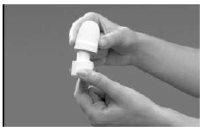
- Відкриття: Утримуючи інгалятор у вертикальному положенні, відкрийте пристрій, повертаючи мундштук у напрямку стрілки, як показано на зображенні.
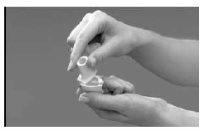
- Завантаження: Перевірте, чи ваші руки сухі; вийміть капсулу з упаковки інгалятора і помістіть її в інгалятор, як показано на ілюстрації.
Немає значення, з якого боку вставляється капсула в камеру.
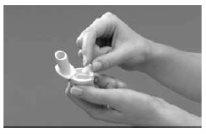
- Закриття: Тримаючи пристрій у вертикальному положенні, поверніть мундштук у положення закриття, поки не почуєте клацання.
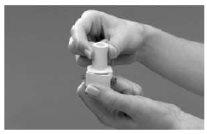
- Перфорування капсули: Тримаючи інгалятор у вертикальному положенні, натисніть одночасно обидва кнопки перфорування, розташовані по боках пристрою.
Зробіть це лише один раз, оскільки перфорування капсули більше одного разу може викликати її розрив або фрагментацію. Перфорування відкриває отвори в капсулі, що дозволяє вийти порошку під час інгаляції.
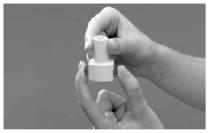
- Підготовка до інгаляції: Нахиліть інгалятор так, щоб мундштук був трохи нижче під кутом 45 градусів, як показано на наступному зображенні, поки капсула не впаде в обертальну камеру. Тримайте пристрій нахиленим у цьому положенні і просіть пацієнта видихнути повністю (поза інгалятором).
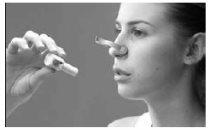
- Інгаляція: Пацієнт повинен трохи нахилити голову назад, і тримаючи інгалятор під кутом 45 градусів, привести його до рота і调整 губи до мундштука. Просіть пацієнта вдихнути швидко і глибоко, щоб наповнити легені. Потім пацієнт повинен утримувати дыхання протягом 5 секунд.
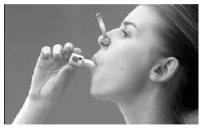
Примітка: Під час правильної інгаляції повинен бути чутний звук "кашля", коли капсула повертається всередині інгалятора.
- Видихання: Вийміть інгалятор з рота пацієнта, і дайте йому видихнути і відновити нормальне дыхання.
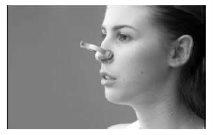
- Перевірка: Щоб капсула Осмогейлу була порожня, вона повинна повертатися всередині інгалятора. Якщо після інгаляції капсула не була порожня, можливо, потрібно провести другу інгаляцію (із тією ж капсулою). Перевірте капсулу після кожної інгаляції.
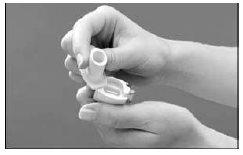
Зверніть увагу:
Інгалятор призначений для ОДНОРАЗОВОГО ВЖИТТЯ (один пристрій для кожної провокаційної проби), і не слід чистити під час проведення проби.
Вийміть інгалятор після кожної провокації з Осмогейлом. Інгалятор не слід стерилізувати чи повторно використовувати, оскільки це може вплинути на цілісність наступних результатів проби.
……………………………………………………………………………………………………..
ПРОЧИТАЙТЕ ПОВНУ ХАРАКТЕРИСТИКУ ПРОДУКТУ ПЕРЕД ВИКОНАННЯМ ЦЬОГО ПРОВОКАЦІЙНОГО ТЕСТУ.
Для отримання більшої інформації зверніться до:
Уповноважений представник:
Pharmaxis Europe Limited
108 Q House Furze Road,
Sandyford, Dublin 18,
D18AY29, Ірландія
Місцевий представник:
Laboratorio Aldo-Unión, S.L.
Baronesa de Maldá, 73
08950 Esplugues de LL.
Барселона
Іспанія
Телефон: +34 93 372 71 11
Факс: +34 93 371 61 98
……………………………………………………………………………………………………..
{Логотип}
Інструкції для провокаційного тесту Осмогейл
……………………………………………………………………………………………………..
Провокаційний тест Осмогейл
Інгалятор
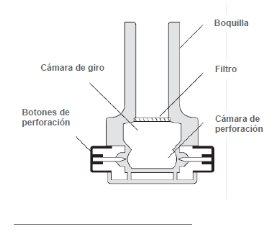

Результати провокаційного тесту
Позитивний результат провокаційного тесту з Осмогейлом
Позитивна відповідь на Осмогейл отримується двома способами:
падіння ≥ 15% FEV1 порівняно з базовим значенням (за допомогою значення FEV1 після введення 0 мг як порівняння)
падіння ≥ 10% FEV1 (між послідовними дозами Осмогейлу)
Негативний результат провокаційного тесту з Осмогейлом
Провокаційний тест з Осмогейлом вважається негативним, якщо пацієнту було введено загальну дозу 635 мг Осмогейлу, і його FEV1 не зменшився на ≥ 15% порівняно з базовим значенням.
Обладнання
Обладнання Осмогейлу(містить капсули Осмогейлу, інгалятор і інструкцію)
Спірометр і мундштук
Носова кліпса
Таймер(який можна налаштувати на 60 секунд)
Калькулятор
Бронходилататор(наприклад салбутамол)
Повинен бути доступний кисень і інші засоби екстреної допомоги згідно зі стандартними протоколами для провокаційних бронхіальних проб.
Важливі моменти, які слід пам'ятати
- Інгалятор призначений для ОДНОРАЗОВОГО ВЖИТТЯ (один пристрій для кожної провокаційної проби), і не слід чистити під час проведення проби. Вийміть інгалятор після кожної провокації з Осмогейлом. Інгалятор не слід стерилізувати чи повторно використовувати, оскільки це може вплинути на цілісність наступних результатів проби.
- Коли пацієнт видихає під час провокаційного тесту з Осмогейлом, переконайтеся, що він робить це ПОДАЛЬШЕ від інгалятора, щоб мінімізувати вологість всередині пристрою.
- Під час перфорування капсули зробіть це лише один раз (натиснувши повністю обидва кнопки одночасно), оскільки нове перфорування може викликати розрив або фрагментацію капсули.
- Використання гумових рукавичок під час проведення проби і маніпуляцій з капсулами Осмогейлу може збільшити статичну електричність і інгібувати рух капсул всередині інгалятора.
- Якщо ви припускаєте, що є проблема зі статичною електричністю, або помітили, що не чутний звук капсули під час інгаляції Осмогейлу, вдайте сильний удар по основі інгалятора однією рукою, тримаючи інгалятор іншою рукою (з мундштуком, спрямованим вниз під кутом 45°). Це гарантує, що капсула "від'єднається" від камери перфорування і потрапляє в обертальну камеру.
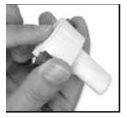
- Інгаляція Осмогейлу може викликати кашель і/або сухість у горлі. Це є звичайним побічним ефектом провокаційного бронхіального тесту.
Ви можете пропонувати пацієнту склянку води після завершення проби.
- Під час цього провокаційного тесту час є важливим, і потрібно встановити і підтримувати осмотичний градієнт. Тривалі інтервали між дозами можуть вплинути на валідність результатів, і їх слід уникати.
……………………………………………………………………………………………………..
Директиви для процедури
КРОК 1:Перевірте, чи пацієнт припинив приймати наступні лікарські засоби (див. таблицю нижче).
Рекомендовані терміни для припинення лікарських засобів.
Відмова від припинення лікарських засобів може вплинути на результати провокаційного тесту з Осмогейлом.
Рекомендовані терміни для припинення лікарських засобів зазвичай базуються на тривалості їх дії.
Термін припинення | Лікарський засіб |
6-8 годин | НЕСТЕРОІДНІ ПРОТИЗАПАЛЬНІ ЛІКАРСЬКІ ЗАСОБИ ДЛЯ ІНГАЛЯЦІЇ наприклад кромоглікат натрію, недокроміл натрію |
8 годин | БЕТА-АГОНІСТИ ДІЇ РАПІД наприклад салбутамол, тербуталін |
12 годин | КОРТИКОСТЕРОЇДНІ ЛІКАРСЬКІ ЗАСОБИ ДЛЯ ІНГАЛЯЦІЇ наприклад беклометазон, будесонід, флутиказон |
12 годин | БРОМУР ІПРАТРОПІЮ |
24 години | КОРТИКОСТЕРОЇДНІ ЛІКАРСЬКІ ЗАСОБИ ДЛЯ ІНГАЛЯЦІЇ ПЛУС БЕТА-АГОНІСТИ ДІЇ ПРОЛОНГОВАНОЇ наприклад флутиказон і салметерол, будесонід і еформотерол |
24 години | БЕТА-АГОНІСТИ ДІЇ ПРОЛОНГОВАНОЇ наприклад салметерол, формотерол |
24 години | ТЕОФІЛІН |
72 години | БРОМУР ТІОТРОПІЮ |
72 години | АНТИГІСТАМІНІ наприклад цетирізин, фексофенадин, лоратадин |
4 дні | АНТАГОНІСТИ РЕЦЕПТОРІВ ЛЕЙКОТРІЕНІВ наприклад монтелукаст |
Харчування:Вживання великих кількостей кави, чаю, коли, шоколаду або інших продуктів, що містять кавеїн, може зменшити бронхіальну реактивність, і їх слід уникати повністю в день дослідження.
Інші чинники, які можуть вплинути на результати:В день проби не слід курити чи виконувати інтенсивні фізичні вправи, оскільки це може вплинути на результати.
КРОК 2:Пацієнт повинен сидіти. Поясніть процедуру; включно вимоги для маневру CVF і вимірювання FEV1, і тип інспіраторного потоку, необхідного для інгалятора. Продемонструйте, якщо це необхідно.
КРОК 3:Введіть дані пацієнта в спірометр (вік, зріст, раса, дата народження, стать тощо).
КРОК 4:Визначте FEV1до провокаційного тесту. Просіть пацієнта виконати маневр CVF згідно з директивами ATS/ERS, виконати три прийнятні маневри, з яких два повинні бути репродукованими. Використовуйте найбільше значення як FEV1 до проби. FEV1 пацієнта повинен бути ≥ 70% від очікуваного значення.
Слід бути обережним з пацієнтами з FEV1 менше 70% від очікуваного значення.
КРОК 5:Обчисліть базовий FEV1 (0 мг)
- Вийміть капсулу 0 мг Осмогейлу з блистера, відкрийте інгалятор (повернувши, як показано на пристрої), вставте капсулу і закрийте пристрій.
- Перфоруйте капсулу один раз, натиснувши кнопки кольору з обох сторін інгалятора.
- Просіть пацієнта носити носову кліпсу і дихати ротом.
- Нахиліть інгалятор під кутом 45° (з мундштуком внизу). Перевірте, чи капсула перейшла з камери перфорування в обертальну камеру, ближчу до мундштука.
Часто можна чути, як капсула падає вперед, або побачити її через отвори з обох сторін пристрою. Передайте інгалятор пацієнту, переконавшись, що він тримає його під тим же кутом.
- Перевірте, чи пацієнт сидить у прямому положенні. Просіть пацієнта видихнути (поза інгалятором), щоб він调整 губи до мундштука інгалятора і зробив швидке і глибоке вдихання, щоб наповнити легені. Під час правильної інгаляції повинен бути чутний звук "кашля", коли капсула повертається всередині пристрою.
- У кінці інгаляції пацієнта запустіть таймер на 60 секунд і просіть пацієнта утримувати дыхання протягом 5 секунд. Після закінчення 5 секунд просіть пацієнта видихнути ротом (подальше від інгалятора), зняти носову кліпсу і дихати нормально.
- Коли таймер спрацює через 60 секунд, просіть пацієнта негайно виконати дві прийнятні вимірювання FEV1. Ці вимірювання повинні бути репродукованими.
- Розрахуйте цільове значення FEV1
Отримується позитивний результат проби провокації з Osmohale, коли FEV1 пацієнта падає ≥ 15% щодо базового значення. Для розрахунку цільового значення FEV1 помножте базове значення (найбільше значення, отримане з 0 мг) попередньо на 0,85. Зареєструйте це значення.
КРОК 6:Капсула 5 мг
- Вставте капсулу 5 мг в інгалаційний пристрій і проколіть її, як вказано в кроці 5.
- Повторіть кроки 5в – ф попереднього.
- Після інгаляції вийміть капсулу з інгалаційного пристрою та перевірте, чи вона повністю порожня; якщо ні, необхідно негайно зробити другу інгаляцію.
- Завантажте капсулу 10 мг як підготовку до наступної дози.
- Через 60 секунд після інгаляції негайно виміряйте двічі FEV1 пацієнта (повинні бути задоволені критерії прийнятності). Використайте найбільше з цих двох значень для розрахунку зміни FEV1.
- Порівняйте значення FEV1 з цією дозою щодо цільового значення FEV1. Якщо значення FEV1 нижче або дорівнює цільовому значенню, або якщо відбулося інкрементне падіння ≥ 10% від попередньої дози, проба провокації є позитивною і завершеною. Якщо ні, негайно продовжуйте наступний етап дозування.
КРОК 7:Капсули 10 мг, 20 мг, 40 мг
Введіть дози 10 мг, 20 мг і 40 мг згідно з попередніми інструкціями (у кроці 6) для дози 5 мг.
КРОК 8:Доза 80 мг (2 капсули 40 мг)
- Вставте і проколіть першу капсулу 40 мг, яка складає дозу 80 мг.
- Пацієнт повинен інгалікувати дозу так само, як і попередні, утримувати дыхання протягом 5 секунд і видихнути.
- Вийміть першу капсулу 40 мг з пристрою та перевірте, чи вона повністю порожня; якщо ні, необхідно негайно зробити другу інгаляцію. Зробіть це після введення кожної капсули.
- Після інгаляції завантажте другу капсулу 40 мг і запропонуйте її пацієнтові негайно після видихнення.
- Пацієнт повинен інгалікувати другу капсулу негайно, щоб гарантувати, що осмотичний ефект Osmohale є кумулятивним.
- Активуйте таймер у кінці інгаляції другої капсули.
- Пацієнт повинен утримувати дыхання протягом 5 секунд перед видихненням.
- Через 60 секунд після інгаляції другої капсули негайно виміряйте двічі FEV1 пацієнта (повинні бути задоволені критерії прийнятності). Використайте найбільше з цих двох значень для розрахунку зміни FEV1.
- Порівняйте значення FEV1 з цією дозою щодо цільового значення FEV1. Якщо значення FEV1 нижче або дорівнює цільовому значенню, або якщо відбулося інкрементне падіння ≥ 10%, проба провокації є позитивною і завершеною. Якщо ні, негайно продовжуйте наступний етап дозування.
КРОК 9:Перша доза 160 мг (4 капсули 40 мг)
- Вставте і проколіть першу капсулу 40 мг, яка складає дозу 160 мг.
- Пацієнт повинен інгалікувати дозу так само, як і попередні, утримувати дыхання протягом 5 секунд і видихнути.
- Вийміть капсулу з пристрою та перевірте, чи вона повністю порожня; якщо ні, необхідно негайно зробити другу інгаляцію. Зробіть це після введення кожної капсули.
- Після інгаляції завантажте другу капсулу 40 мг і запропонуйте її пацієнтові негайно після видихнення.
- Пацієнт повинен інгалікувати вміст другої капсули, утримувати дыхання протягом 5 секунд і видихнути.
5 секунд.
- Після інгаляції завантажте третю капсулу 40 мг і запропонуйте її пацієнтові негайно після видихнення.
- Пацієнт повинен інгалікувати вміст третьої капсули, утримувати дыхання протягом 5 секунд і видихнути.
- Після інгаляції завантажте четверту капсулу 40 мг і запропонуйте її пацієнтові негайно після видихнення.
- Пацієнт повинен інгалікувати четверту капсулу негайно, щоб гарантувати, що осмотичний ефект Osmohale є кумулятивним.
- Активуйте таймер у кінці інгаляції четвертої капсули.
- Пацієнт повинен утримувати дыхання протягом 5 секунд перед видихненням.
- Через 60 секунд після інгаляції четвертої капсули негайно виміряйте двічі FEV1 пацієнта (повинні бути задоволені критерії прийнятності). Використайте найбільше з цих двох значень для розрахунку зміни FEV1.
- Порівняйте значення FEV1 з цією дозою щодо цільового значення FEV1. Якщо значення FEV1 нижче або дорівнює цільовому значенню, або якщо відбулося інкрементне падіння ≥ 10% від попередньої дози, проба провокації є позитивною і завершеною. Якщо ні, негайно продовжуйте наступний етап дозування.
КРОК 10:Друга доза 160 мг (4 капсули 40 мг)
Введіть другу дозу 160 мг згідно з інструкціями попереднього кроку 9.
КРОК 11:Третя доза 160 мг (4 капсули 40 мг)
Введіть третю дозу 160 мг згідно з інструкціями попереднього кроку 9.
Після закінчення цієї дози буде введено 635 мг. Якщо не було отримано позитивної відповіді, пробу провокації слід вважати завершеною і з негативним результатом.
КРОК 12:Після закінчення проби провокації слід введення бронходилататора пацієнтові та контролювати його протягом 15 хвилин, щоб гарантувати, що його FEV1 повернулося до значення, складає 5% попереднього рівня до проби. (У разі негативного результату введення бронходилататора є опціональним).
- Країна реєстрації
- Доступність у аптекахПроблеми з постачанням
- Діючі речовини
- Потрібен рецептТак
- Виробник
- Інформація є довідковою і не є медичною порадою. Перед прийомом будь-яких препаратів обов'язково проконсультуйтеся з лікарем. Oladoctor не несе відповідальності за медичні рішення, прийняті на основі цього контенту.
- Альтернативи до ОСМОХАЛЕ ПОРОШОК ДЛЯ ІНГАЛЯЦІЙ (ТВЕРДІ КАПСУЛИ)Форма випуску: РОЗЧИН ДЛЯ ІН'ЄКЦІЙ, 25 мг бромід едрофонію/2 млДіючі речовини: edrophoniumВиробник: Mana Pharma S.L.Потрібен рецептПотрібен рецептПотрібен рецепт
Лікарі онлайн щодо ОСМОХАЛЕ ПОРОШОК ДЛЯ ІНГАЛЯЦІЙ (ТВЕРДІ КАПСУЛИ)
Консультація щодо дозування, побічних ефектів, взаємодій, протипоказань та поновлення рецепта на ОСМОХАЛЕ ПОРОШОК ДЛЯ ІНГАЛЯЦІЙ (ТВЕРДІ КАПСУЛИ) – за рішенням лікаря та згідно з місцевими правилами.














